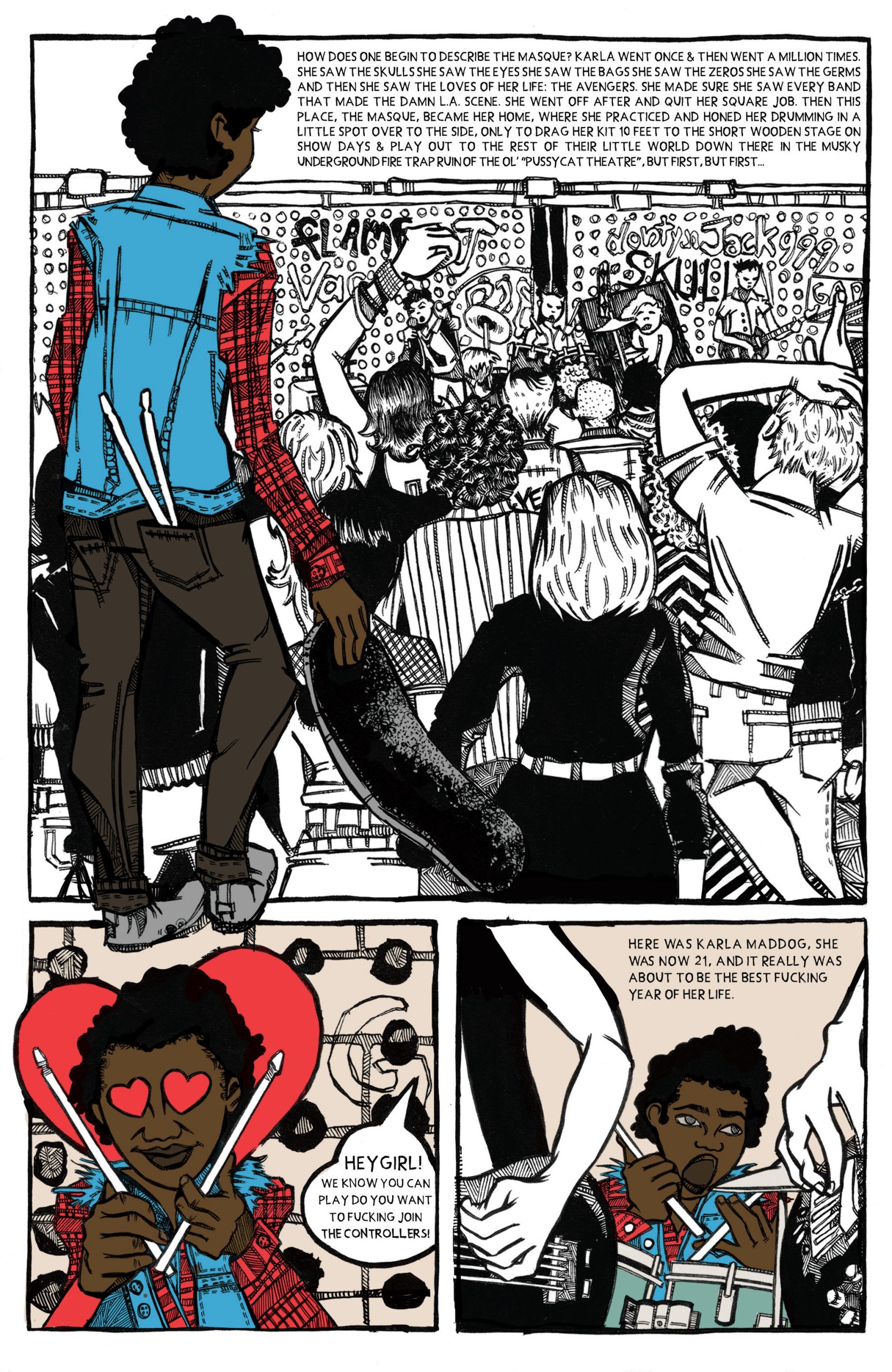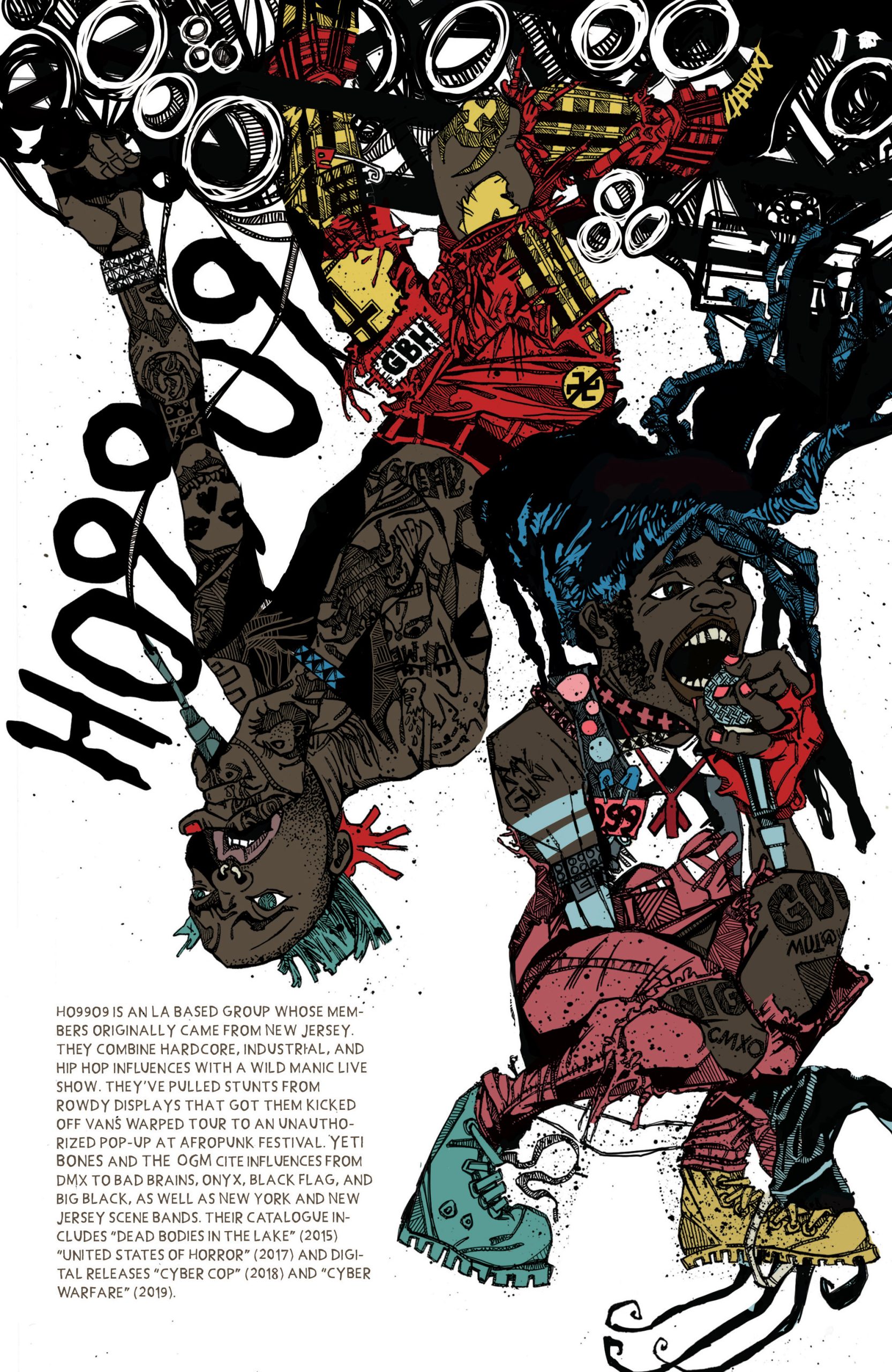Raeghan Buchanan’s The Secret History of Black Punk: Record Zero is equal parts comic, zine, and liner notes for a killer mix tape. If you love music, you’ll be inspired to keep jumping onto YouTube to see and hear the artists Buchanan writes so passionately about. Her aim is to present the criminally overlooked black players who have made so many great contributions to music ever since rock 'n roll was first committed to tape. Quite rightly pointed out in the book’s opening pages, the first-ever recording of the rock style needs to be credited to Sister Rosetta Tharpe and her "Strange Things Happening Every Day". At six pages, Buchanan’s biography of Tharpe is the longest section dedicated to a single artist in the book. But that’s the point of this issue zero, to provide a compendium from which to expand upon later entries. And if Record Zero is a testing of the waters, then rest assured conditions are favorable for the proposed voyage.
While the remaining space for each act is pretty tight, most only portrayed over one or two pages, Buchanan has a real knack for getting across intriguing facts - the stuff that makes you appreciate and want to hear a band. How ESG got their name, Jean Beauvoir’s work with the Plasmatics and beyond, the awesome intensity of Karla Maddog Duplantier’s devotion to music, or just that the singer/guitarist of Black Death is named Siki Spacek. The full roster includes Death, Pure Hell, Poly Styrene, Pat Smear, Don Letts, Black Death, Pauline Black, Michael Holman, author Hanif Abdurraqib (and his lovely tribute to Love’s Arthur Lee), Bobby Porter, Killer of Sheep, Stefan Burnett (aka MC Ride from Death Grips), Mick Collins, Kayla Phillips, Lamont ‘Bim’ Thomas, Ho99o9, Big Joanie, Nova Twins, FUPU, Negro Terror, The 1865, and Minority Threat. And although the author’s point about white people asking black punks if they’ve heard Bad Brains is well-taken, the band does get two pages, making one think Buchanan’s handling of the DC godfathers’ story would be an interesting read. What’s great about all these acts is that, while they are punk in spirit and attitude, the music they make transcends that genre’s limitations, taking on aspects of many different styles. Punk was about self-expression, after all. The multi-faceted nature of the music is something that Buchanan subtly—sometimes it even seems unintentionally—states over the course of the book, before driving this point home in a letter to the reader on the last page.
Although these final thoughts are addressed to the reader, Buchanan's tone throughout is conversational and all the better for it. Hearing someone else’s enthusiasm for something is what gets us excited the most, rather than just statements of fact. Buchanan comes across as a real fan - someone for whom music and all that goes with it inspires her enough to tell these stories, and she has the talent to do it in a unique and visually impressive way. There’s a natural flow to her prose too, rhymes popping up here and there, adding to the pleasure of the reading experience. She’ll also fully confess to not knowing an artist that well but wanting to present them anyway so that we all, herself included, can explore more of their work. One example of this is right on her opening page, when she mentions “grunge goddess Tina Bell,” who was a major figure in the early Seattle scene, fronting Bam Bam during the '80s. A future volume dedicated to this legend, written and illustrated by Buchanan, would be something to look forward to indeed.
In line with its contents, the book comes across as a punk fanzine, though a very good-looking one. No uniform font, color, or even direction of the text. There’s a wonderful full page announcement 2/3 of the way through–“WARNING THE LAST THIRD of this thing IS MILDLY DISORDERED CHRONOLOGICALLY”–giving Buchanan a chance to hype a lot of newer bands. This is not to say that the book is amateurish in any way, and should be applauded for being as slick as it is while still retaining these punk sensibilities. The images all snarl, whether the face is doing so or not - full of the manic energy that made punk such a spectacle on stage, whilst also retaining each individual’s unique character. The Selecter’s Pauline Black looks slick as hell, while a few pages later Jean Beauvoir comes across as a space-age lion with his golden mohawk, letting loose his roar. Pure Hell get three pages of text, a biography mixed with Buchanan’s adulation, and her rendering of them as gutter-glam superheroes, all with different colored hair–though hardly an exaggeration of how they looked in real life–demands that they are worthy of their own comic. The single shot portrayals of MC Ride, Kayla Phillips, Ho99o9, and FUPU are intense. There are quite a few double-page spreads throughout, including Bobby Porter caught in continuous motion doing a one-handed cartwheel on stage whilst singing a medley of his songs. The book's center two pages are dedicated to a powerful rendering of Basquiat alongside info on Gray, his ‘musical’ collaboration with Michael Holman. The text here is all block capital reds, with spaces purposefully left within words, "PART Y" and "YE LLOWS" - a wonderfully confounding nod to zines of the original time period. The use of color throughout is fantastic, really adding to the visual appeal, whether it be for a full illustration, a splash to highlight, or even just the shade of a passage of text. A full four-page Reference section rounds out the book, noting the texts researched and photos referenced.
As Buchanan states on page one, “this is a love letter.” And on every page one feels her love and admiration for all these incredible artists - along with a certain despair at their not getting the recognition they so rightly deserve. The Secret History of Black Punk: Record Zero goes a little way towards rectifying that. And if Buchanan continues with this series as she intends, giving fuller biographies of more and more acts, then these books should be on every music curriculum in every school, to point the way to the lost, real originators that have been whitewashed out of history by culture at large.
The post The Secret History of Black Punk: Record Zero appeared first on The Comics Journal.



No comments:
Post a Comment